The Effect of Cooling Temperature on Microstructure and Mechanical Properties of Al 6061-T6 Aluminum Alloy during Submerged Friction Stir Welding
Abstract
1. Introduction
2. Materials and Methods
3. Results and Discussion
3.1. Macrostructure Evolution of the Joints
3.2. Microstructure Analysis through EBSD
3.3. Microhardness Distributions of the Joints
3.4. Tensile Properties of Joints
3.5. Fractography
4. Conclusions
- The microhardness distribution of as-welded joints showed a typical “W” shape characteristics under all welding conditions. The highest value of the hardness was 95 HV0.1 at the 80 °C water temperature. The lowest hardness, 62 HV0.1, occurs at the HAZ of the advancing side for IA joints.
- A fine and balanced microstructure can be found in SZ. The grain size of samples IA, WC, WR, and WH in the SZ is 8.1 μm, 2.43 μm, 3.21 μm, and 6.1 μm, respectively. It was observed that joints welded in a WC condition restricted the grain growth during FSW and showed the smallest grain size. The nugget zones’ grains are smaller in all water cooling media conditions compared to air condition.
- With the increase of the cooling water temperature, the strength of the welded joint marginally increases. Among the all-weld joints, WH weld joints showed the best mechanical characteristics with an ultimate tensile strength of 82.1% and an elongation of 14%.
- The ductile mode of fracture was observed in IA weld joints. All SFSW joints indicated a mixed failure mode involving a cleavage mode of ductile and brittle fractures.
Author Contributions
Funding
Data Availability Statement
Conflicts of Interest
Nomenclature
| AS | Advancing side |
| BM | Base material |
| FSW | Friction stir welding |
| HAZ | Heat affected zone |
| IA | Normal air FSW |
| IMCs | Intermetallic compounds |
| PDZ | Pin-driven zone |
| RS | Retreating side |
| SDZ | Shoulder-driven zone |
| SFSW | Submerged friction stir welding |
| SZ | Stir zone |
| TMAZ | Thermomechanically affected zone |
| UTS | Ultimate tensile strength |
| WC | Cold water SFSW at 0 °C |
| WH | Hot water SFSW at 80 °C |
| WR | Room water SFSW at 35 °C |
References
- Rathinasuriyan, C.; Pavithra, E.; Sankar, R.; Kumar, V.S.S. Current Status and Development of Submerged Friction Stir Welding: A Review. Int. J. Precis. Eng. Manuf. Green Technol. 2021, 8, 687–701. [Google Scholar] [CrossRef]
- Rodríguez, A.; Calleja, A.; López de Lacalle, L.N.; Pereira, O.; González, H.; Urbikain, G.; Laye, J. Burnishing of FSW aluminum Al–Cu–Li components. Metals 2019, 9, 260. Available online: https://www.mdpi.com/2075-4701/9/2/260 (accessed on 21 February 2019). [CrossRef]
- Rathinasuriyan, C.; Kumar, V.S.S. Optimisation of submerged friction stir welding parameters of aluminium alloy using RSM and GRA. Adv. Mater. Process Technol. 2021, 7, 696–709. [Google Scholar] [CrossRef]
- Vivas, J.; Fernández-Calvo, A.I.; Aldanondo, E.; Irastorza, U.; Álvarez, P. Friction Stir Weldability at High Welding Speed of Two Structural High Pressure Die Casting Aluminum Alloys. J. Manuf. Mater Process 2022, 6, 160. [Google Scholar] [CrossRef]
- Fuse, K.; Badheka, V. Bobbin tool friction stir welding: A review. Sci. Technol. Weld. Join 2019, 24, 277–304. [Google Scholar] [CrossRef]
- López de Lacalle, L.N.; Urbikain Pelayo, G.; Azkona, I.; Verbiţchi, V.; Cojocaru, R.; Boţilă, L.N.; Ciucă, C.; Perianu, I.A.; Vlascici, M. Functional layers of aluminium alloy on steel made by alternative friction processes, for elements of metal structures. In Advanced Materials Research; Trans Tech Publications Ltd: Bäch, Switzerland, 2018; Volume 1146, pp. 106–114. Available online: https://www.scientific.net/AMR.1146.106 (accessed on 10 April 2018).
- Wahid, M.A.; Khan, Z.A.; Siddiquee, A.N.; Shandley, R.; Sharma, N. Analysis of process parameters effects on underwater friction stir welding of aluminum alloy 6082-T6. Proc. Inst. Mech. Eng. B J. Eng. Manuf. 2019, 233, 1700–1710. [Google Scholar] [CrossRef]
- Wahid, M.o.h.d.A.; Khan, Z.A.; Siddiquee, A.N. Review on underwater friction stir welding: A variant of friction stir welding with great potential of improving joint properties. Trans Nonferrous Met. Soc. China 2018, 28, 193–219. [Google Scholar] [CrossRef]
- Sánchez Egea, A.J.; Rodríguez, A.; Celentano, D.; Calleja, A.; López de Lacalle, L.N. Joining metrics enhancement when combining FSW and ball-burnishing in a 2050 aluminium alloy. Surf. Coat. Technol. 2019, 367, 327–335. [Google Scholar] [CrossRef]
- Ahmed, M.M.Z.; El-Sayed Seleman, M.M.; Fydrych, D.; Çam, G. Friction Stir Welding of Aluminum in the Aerospace Industry: The Current Progress and State-of-the-Art Review. Materials 2023, 16, 2971. [Google Scholar] [CrossRef]
- Cao, F.; Huang, G.; Hou, W.; Ni, R.; Sun, T.; Hu, J.; Shen, Y.; Gerlich, A.P. Simultaneously enhanced strength-ductility synergy and corrosion resistance in submerged friction stir welded super duplex stainless steel joint via creating ultrafine microstructure. J. Mater. Process. Technol. 2022, 307, 117660. [Google Scholar] [CrossRef]
- Heirani, F.; Abbasi, A.; Ardestani, M. Effects of processing parameters on microstructure and mechanical behaviors of underwater friction stir welding of Al5083 alloy. J. Manuf. Process 2017, 25, 77–84. [Google Scholar] [CrossRef]
- Liu, H.; Zhang, H.; Huang, Y.; Yu, L. Mechanical properties of underwater friction stir welded 2219 aluminum alloy. Trans Nonferrous Met. Soc. China 2010, 20, 1387–1391. [Google Scholar] [CrossRef]
- Shanavas, S.; Edwin Raja Dhas, J.; Murugan, N. Weldability of marine grade AA 5052 aluminum alloy by underwater friction stir welding. Int. J. Adv. Manuf. Technol. 2018, 95, 4535–4546. [Google Scholar] [CrossRef]
- Derazkola, H.A.; Khodabakhshi, F. Underwater submerged dissimilar friction-stir welding of AA5083 aluminum alloy and A441 AISI steel. Int. J. Adv. Manuf. Technol. 2019, 102, 4383–4395. [Google Scholar] [CrossRef]
- Mahto, R.P.; Gupta, C.; Kinjawadekar, M.; Meena, A.; Pal, S.K. Weldability of AA6061-T6 and AISI 304 by underwater friction stir welding. J. Manuf. Process 2019, 38, 370–386. [Google Scholar] [CrossRef]
- Zhao, Y.; Lu, Z.; Yan, K.; Huang, L. Microstructural characterizations and mechanical properties in underwater friction stir welding of aluminum and magnesium dissimilar alloys. Mater. Des. 1980–2015 2015, 65, 675–681. [Google Scholar] [CrossRef]
- Zhang, J.; Shen, Y.; Yao, X.; Xu, H.; Li, B. Investigation on dissimilar underwater friction stir lap welding of 6061-T6 aluminum alloy to pure copper. Mater. Des. 2014, 64, 74–80. [Google Scholar] [CrossRef]
- Lader, S.K.; Baruah, M.; Ballav, R. Improvement in the weldability and mechanical properties of CuZn40 and AA1100-O dissimilar joints by underwater friction stir welding. J. Manuf. Process 2023, 85, 1154–1172. [Google Scholar] [CrossRef]
- Liu, H.J.; Zhang, H.J.; Yu, L. Effect of welding speed on microstructures and mechanical properties of underwater friction stir welded 2219 aluminum alloy. Mater. Des. 2011, 32, 1548–1553. [Google Scholar] [CrossRef]
- Zhang, H.J.; Liu, H.J.; Yu, L. Microstructure and mechanical properties as a function of rotation speed in underwater friction stir welded aluminum alloy joints. Mater. Des. 2011, 32, 4402–4407. [Google Scholar] [CrossRef]
- Wakchaure, K.N.; Thakur, A.G. Mathematical and experimental examination of the effect of the stepped pin tool profile on the characterization of AA 6061-T6 underwater friction stir welding. Metall. Mater. Eng 2022, 28, 593–624. [Google Scholar] [CrossRef]
- Khalafe, W.H.; Sheng, E.L.; Bin Isa, M.R.; Omran, A.B.; Shamsudin, S.B. The Effect of Friction Stir Welding Parameters on the Weldability of Aluminum Alloys with Similar and Dissimilar Metals: Review. Metals 2022, 12, 2099. [Google Scholar] [CrossRef]
- Walz, D.; Göbel, R.; Werz, M.; Weihe, S. Effect of Weld Length on Strength, Fatigue Behaviour and Microstructure of Intersecting Stitch-Friction Stir Welded AA 6016-T4 Sheets. Materials 2023, 16, 533. [Google Scholar] [CrossRef]
- Zhang, H.; Liu, H. Mathematical model and optimization for underwater friction stir welding of a heat-treatable aluminum alloy. Mater. Des. 2013, 45, 206–211. [Google Scholar] [CrossRef]
- Zhang, H.; Liu, H.; Yu, L. Thermal modeling of underwater friction stir welding of high strength aluminum alloy. Trans Nonferrous Met. Soc. China 2013, 23, 1114–1122. [Google Scholar] [CrossRef]
- Wakchaure, K.; Thakur, A. Mechanical and microstructural characteristics of underwater friction stir welded AA 6061-T6 joints using a hybrid GRA-artificial neural network approach. Mater Phys. Mech. 2023, 93, 119–141. [Google Scholar] [CrossRef]
- Memon, S.; Tomków, J.; Derazkola, H.A. Thermo-Mechanical Simulation of Underwater Friction Stir Welding of Low Carbon Steel. Materials 2021, 14, 4953. [Google Scholar] [CrossRef] [PubMed]
- Liu, W.; Yan, Y.; Sun, T.; Wu, S.; Shen, Y. Influence of cooling water temperature on ME20M magnesium alloy submerged friction stir welding: A numerical and experimental study. Int. J. Adv. Manuf. Technol. 2019, 105, 5203–5215. [Google Scholar] [CrossRef]
- Fuse, K.; Badheka, V. Hybrid self-reacting friction stir welding of AA 6061-T6 aluminium alloy with cooling assisted approach. Metals 2020, 11, 16. Available online: https://www.mdpi.com/2075-4701/11/1/16 (accessed on 24 December 2020). [CrossRef]
- Li, G.; Zhou, L.; Luo, S.; Dong, F.; Guo, N. Microstructure and mechanical properties of bobbin tool friction stir welded ZK60 magnesium alloy. Mater Sci. Eng. A 2020, 776, 138953. [Google Scholar] [CrossRef]
- Rui-Dong, F.; Zeng-Qiang, S.; Rui-Cheng, S.; Ying, L.; Hui-Jie, L.; Lei, L. Improvement of weld temperature distribution and mechanical properties of 7050 aluminum alloy butt joints by submerged friction stir welding. Mater. Des. 2011, 32, 4825–4831. [Google Scholar] [CrossRef]
- Li, Y.; Sun, D.; Gong, W. Effect of Tool Rotational Speed on the Microstructure and Mechanical Properties of Bobbin Tool Friction Stir Welded 6082-T6 Aluminum Alloy. Metals 2019, 9, 894. [Google Scholar] [CrossRef]
- Li, G.; Zhou, L.; Zhang, H.; Luo, S.; Guo, N. Effects of traverse speed on weld formation, microstructure and mechanical properties of ZK60 Mg alloy joint by bobbin tool friction stir welding. Chin. J. Aeronaut. 2021, 34, 238–250. [Google Scholar] [CrossRef]
- Dursun, T.; Soutis, C. Recent developments in advanced aircraft aluminium alloys. Mater. Des. 1980–2015 2014, 56, 862–871. [Google Scholar] [CrossRef]
- Liang, H.; Yan, K.; Wang, Q.; Zhao, Y.; Liu, C.; Zhang, H. Improvement in Joint Strength of Spray-Deposited Al-Zn-Mg-Cu Alloy in Underwater Friction Stir Welding by Altered Temperature of Cooling Water. J. Mater. Eng. Perform. 2016, 25, 5486–9543. [Google Scholar] [CrossRef]
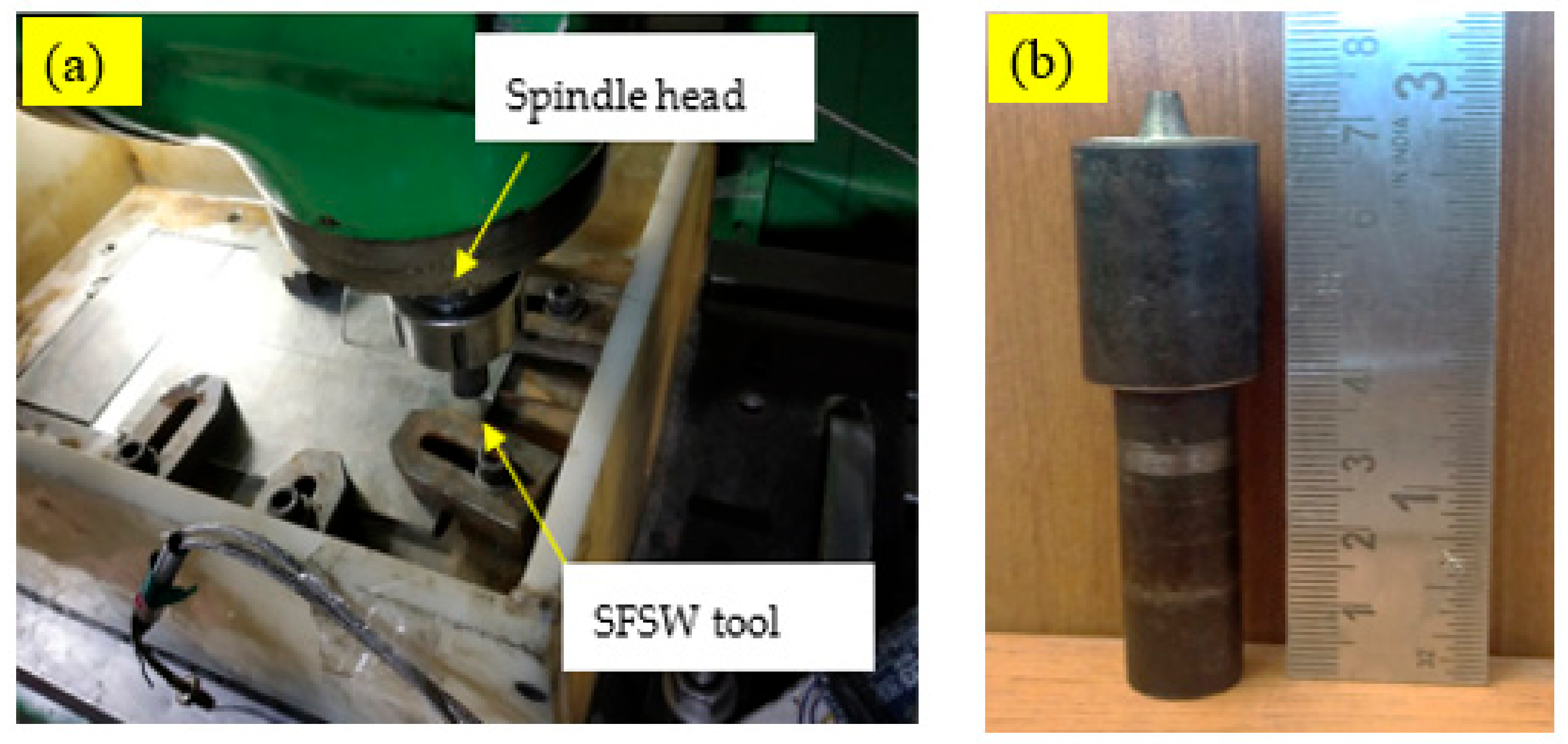
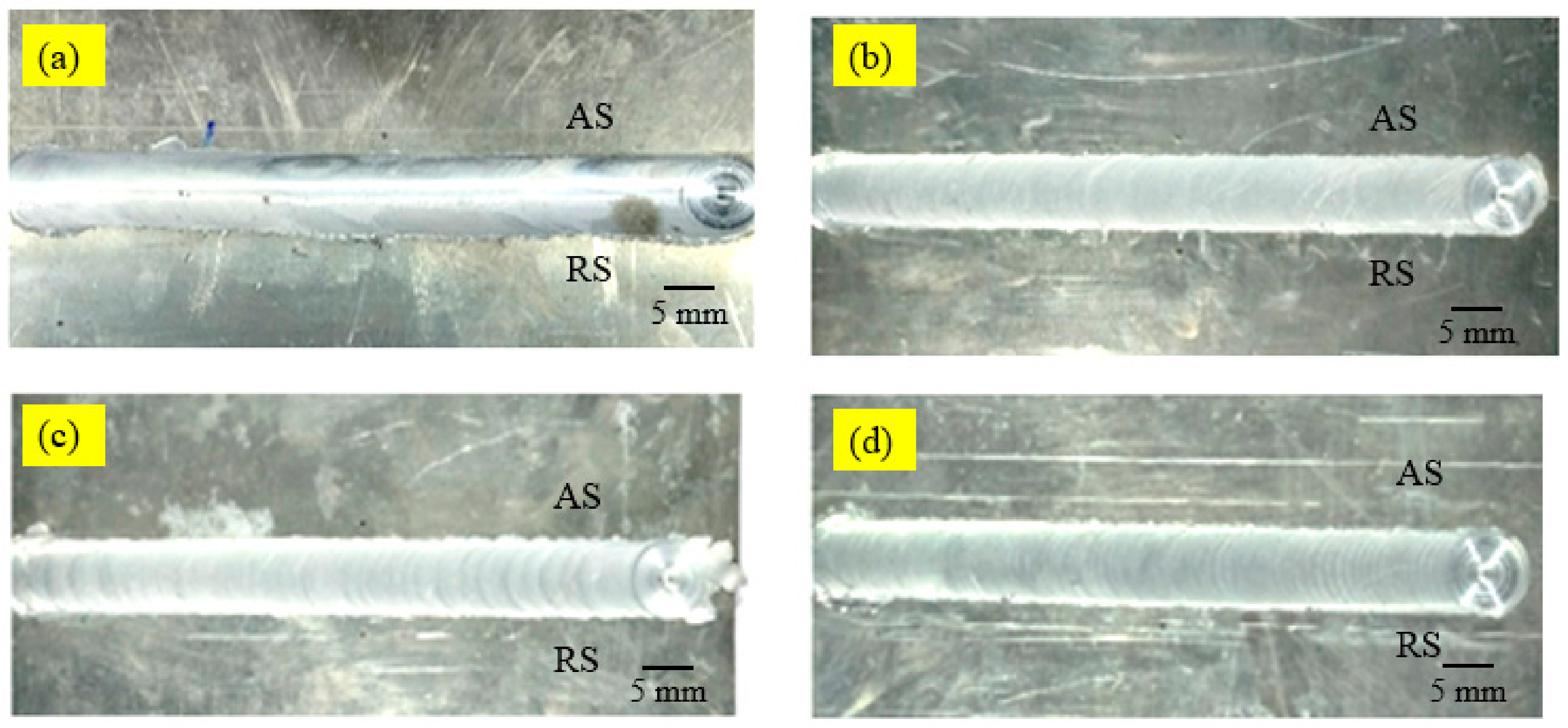
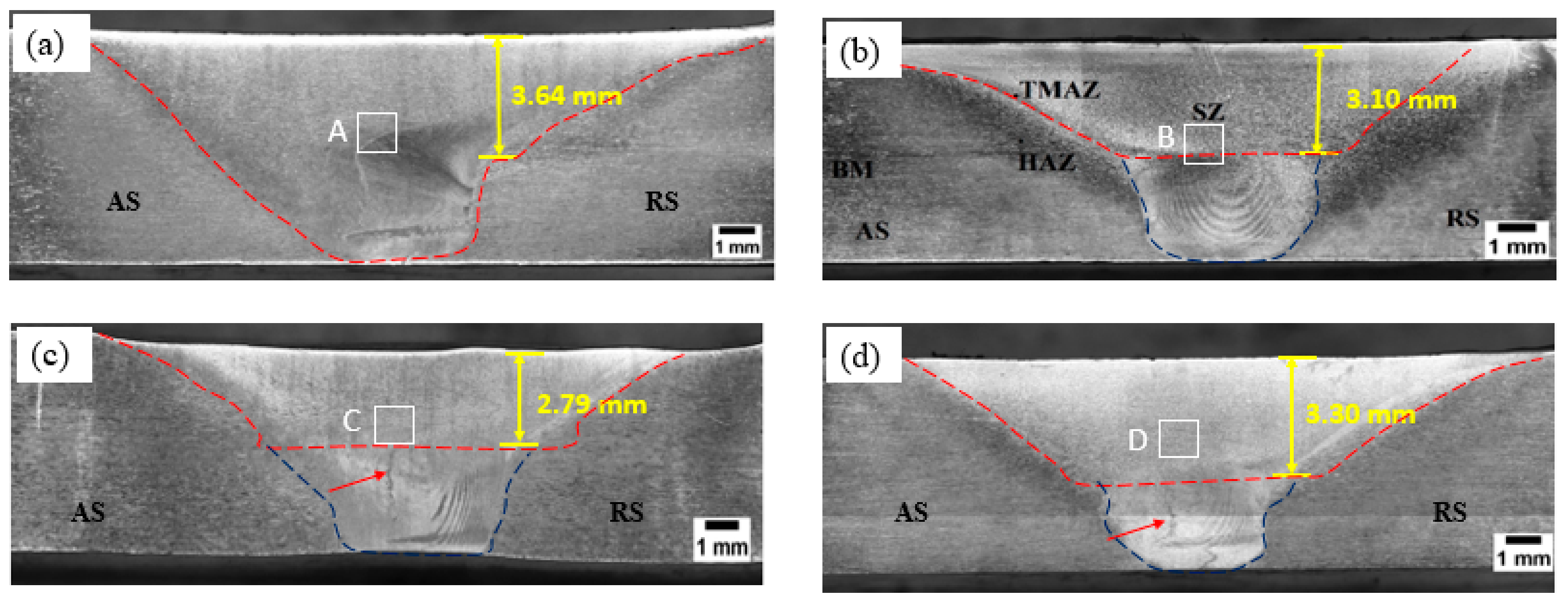
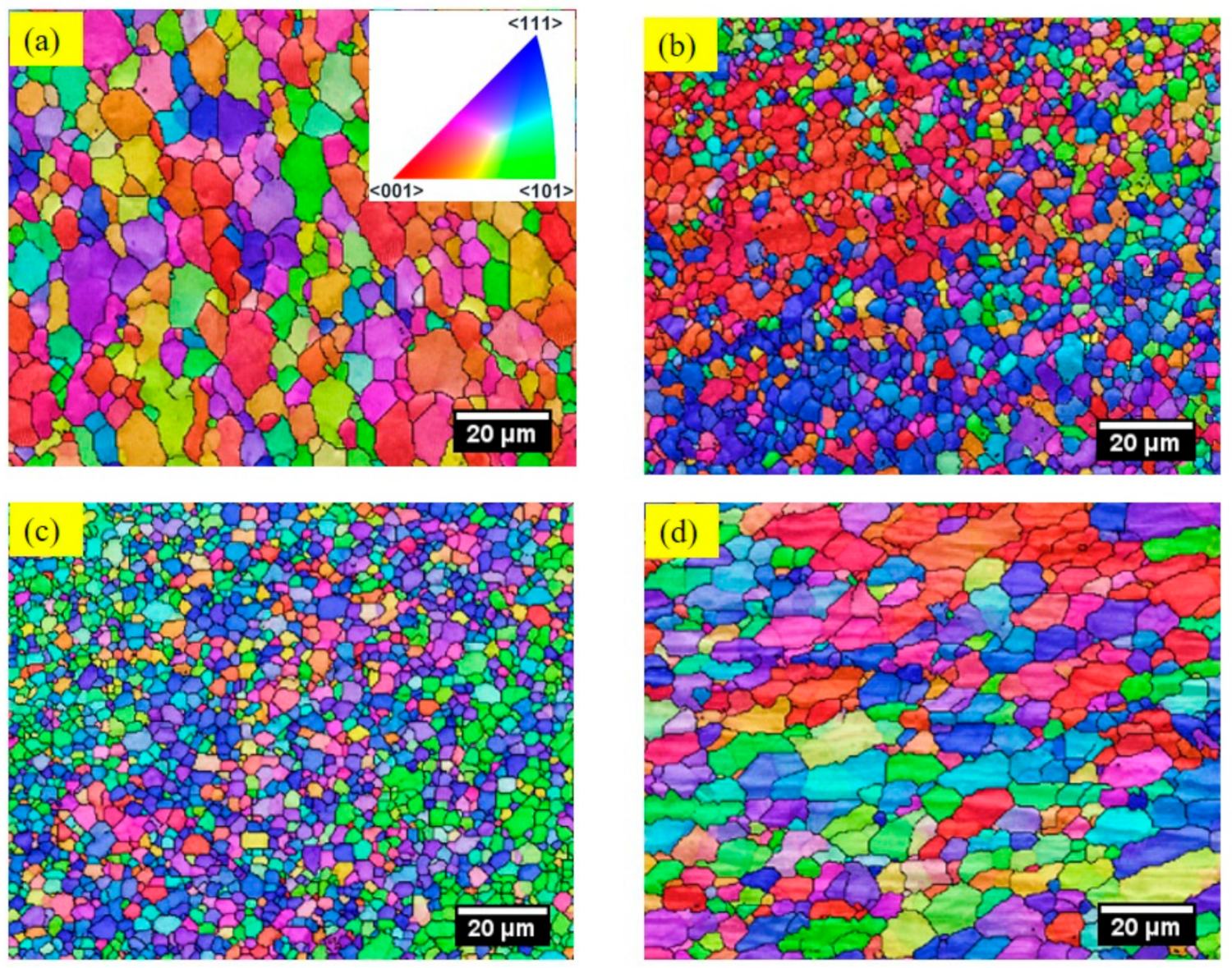
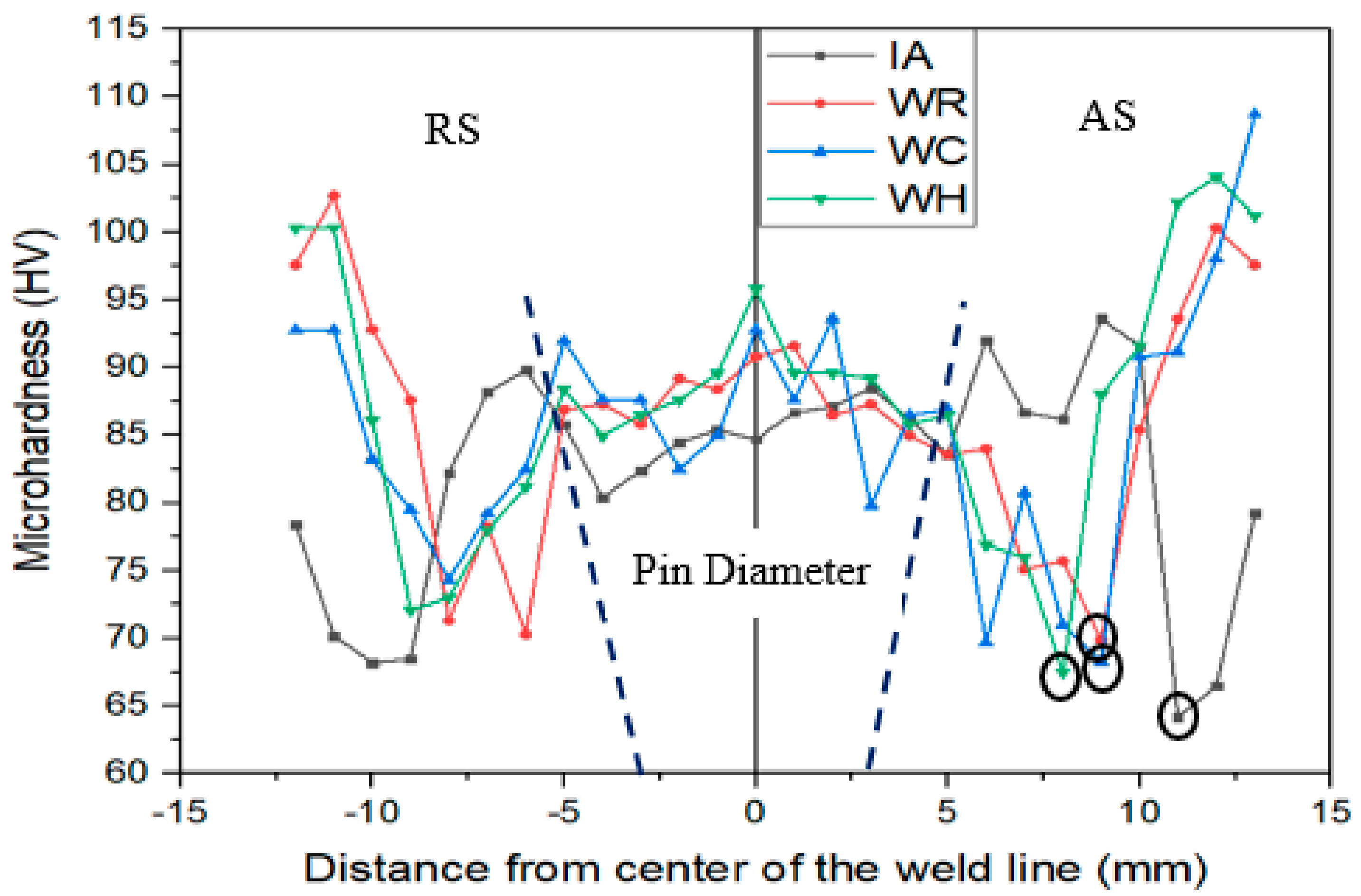
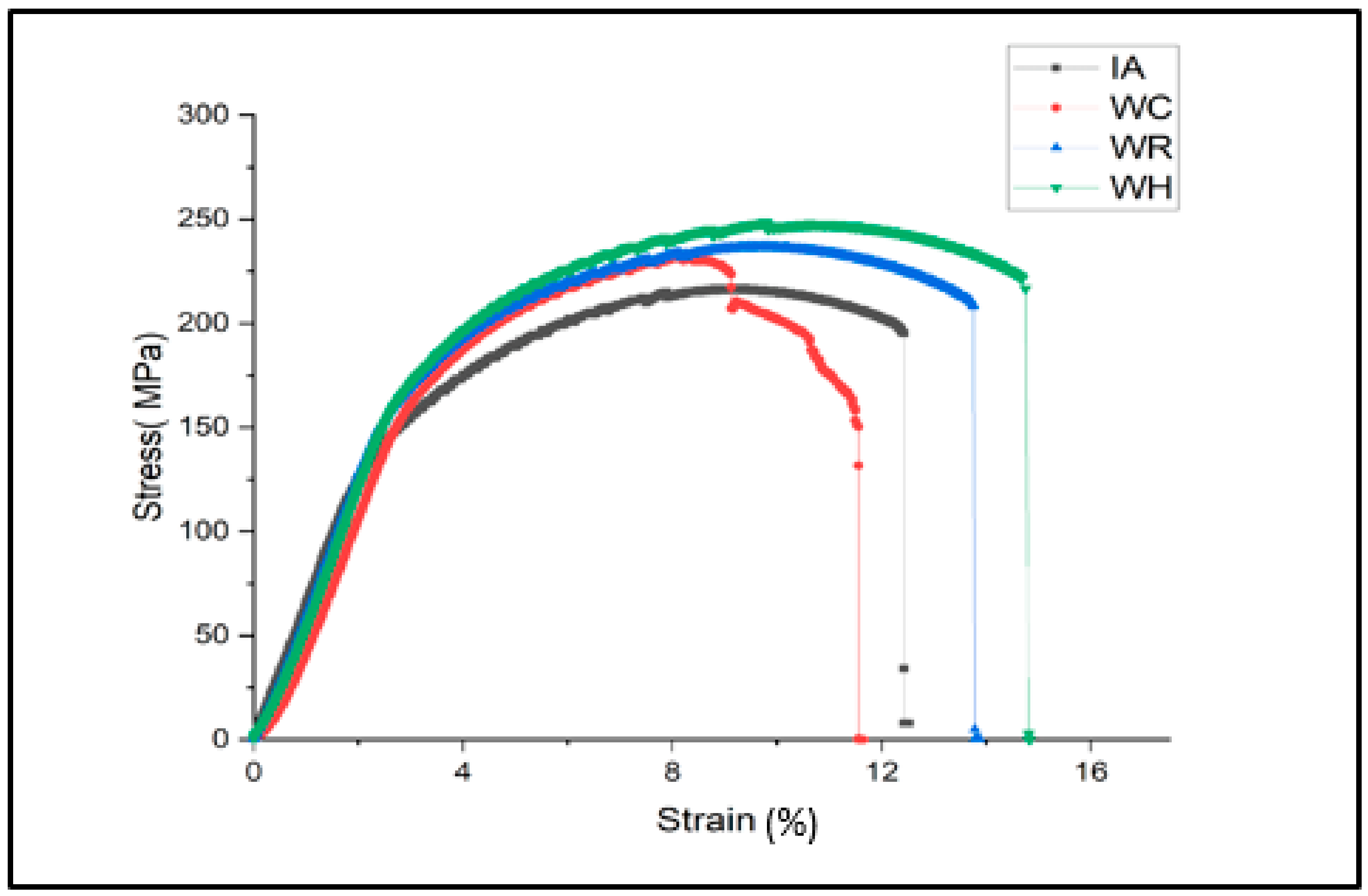
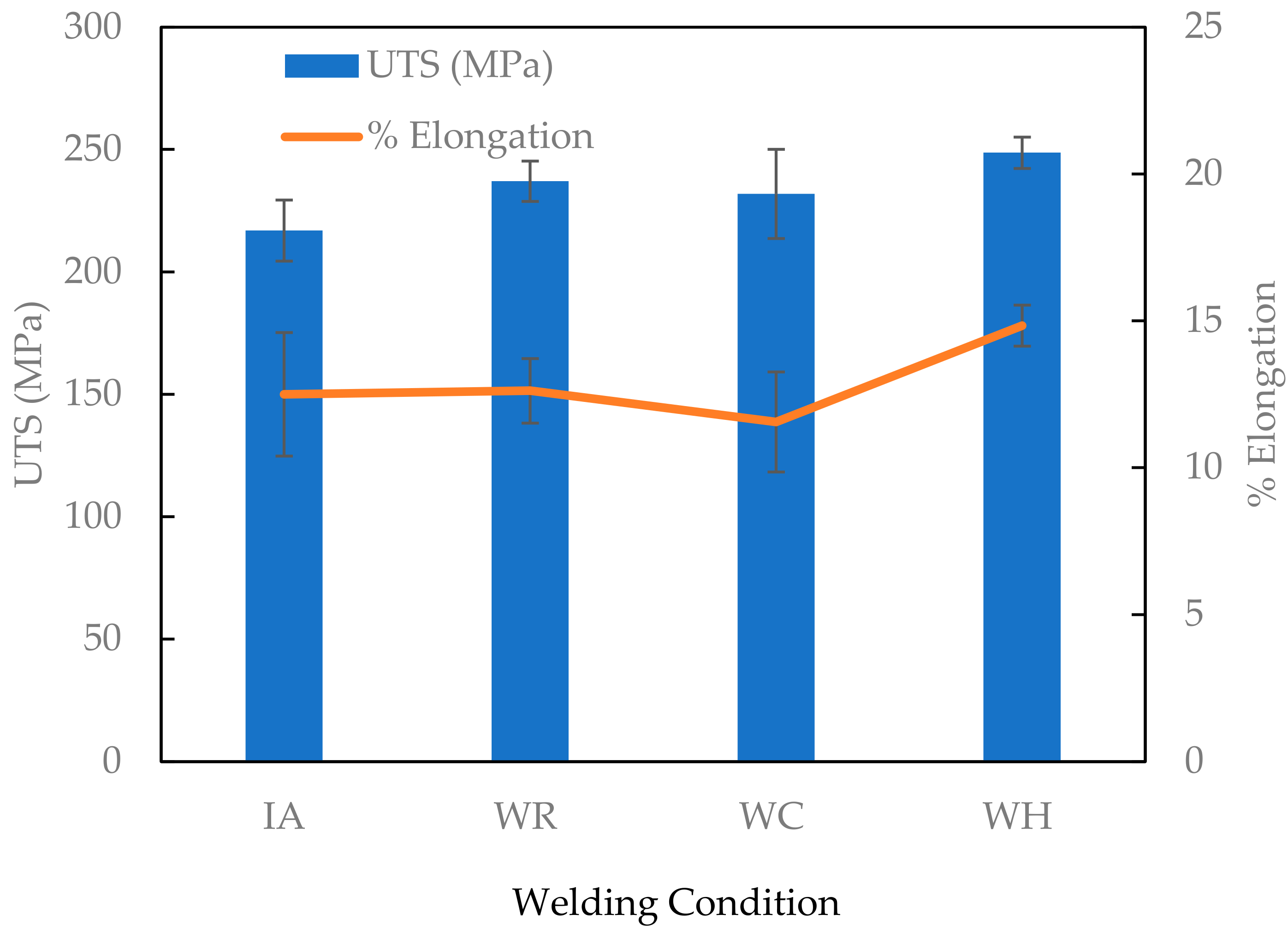
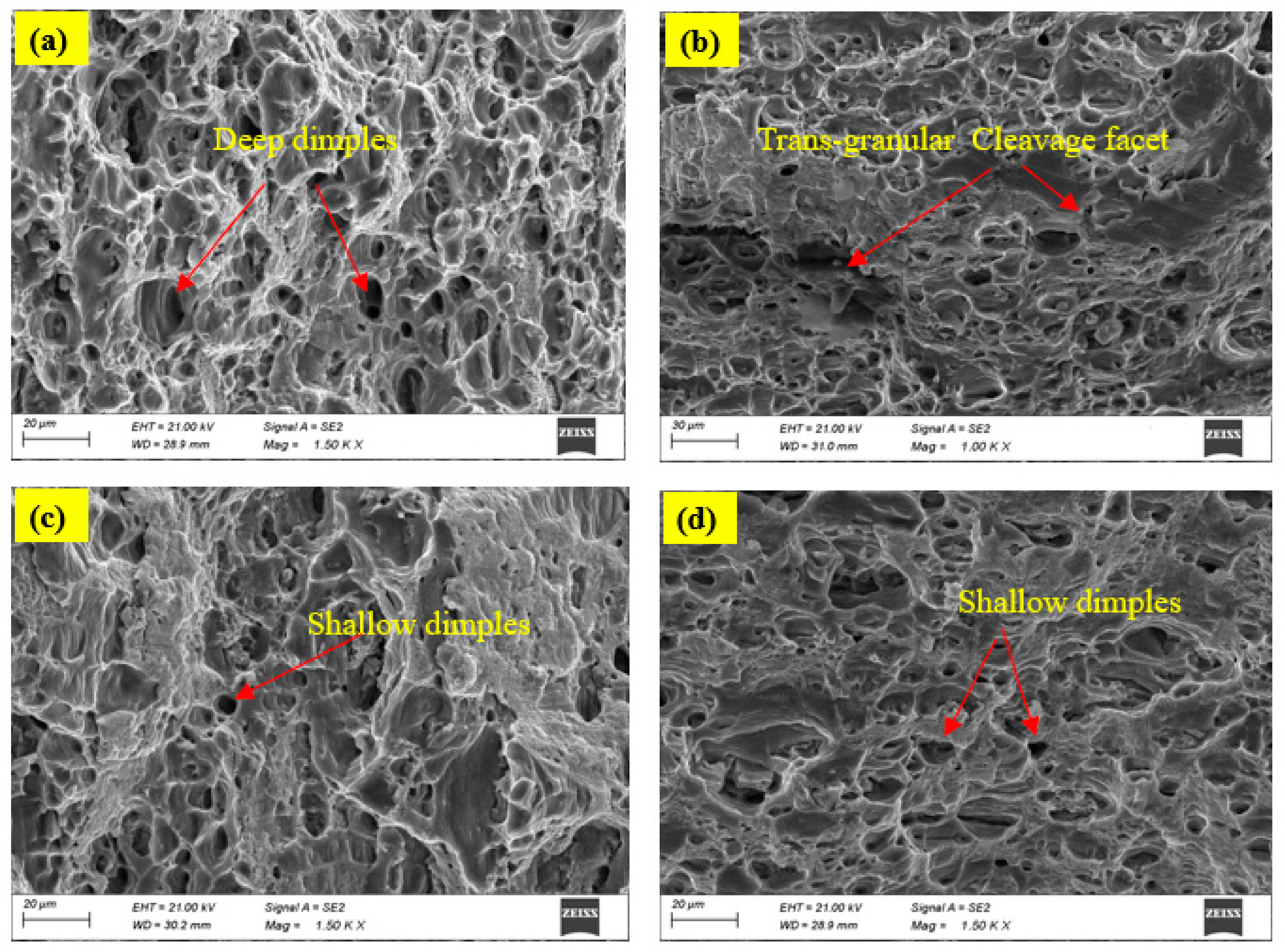
| Chemical Composition | Mechanical PROPERTIES | |||||||||
|---|---|---|---|---|---|---|---|---|---|---|
| Elements | Mg | Si | Mn | Zn | Fe | Cu | Al | UTS (MPa) | YS (MPa) | % Elongation |
| Alloying elements (%) | 1.14 | 0.67 | 0.12 | 0.25 | 0.35 | 0.30 | Rest | 307 | 275 | 20 |
Disclaimer/Publisher’s Note: The statements, opinions and data contained in all publications are solely those of the individual author(s) and contributor(s) and not of MDPI and/or the editor(s). MDPI and/or the editor(s) disclaim responsibility for any injury to people or property resulting from any ideas, methods, instructions or products referred to in the content. |
© 2023 by the authors. Licensee MDPI, Basel, Switzerland. This article is an open access article distributed under the terms and conditions of the Creative Commons Attribution (CC BY) license (https://creativecommons.org/licenses/by/4.0/).
Share and Cite
Wakchaure, K.; Chaudhari, R.; Thakur, A.; Fuse, K.; Lopez de Lacalle, L.N.; Vora, J. The Effect of Cooling Temperature on Microstructure and Mechanical Properties of Al 6061-T6 Aluminum Alloy during Submerged Friction Stir Welding. Metals 2023, 13, 1159. https://doi.org/10.3390/met13071159
Wakchaure K, Chaudhari R, Thakur A, Fuse K, Lopez de Lacalle LN, Vora J. The Effect of Cooling Temperature on Microstructure and Mechanical Properties of Al 6061-T6 Aluminum Alloy during Submerged Friction Stir Welding. Metals. 2023; 13(7):1159. https://doi.org/10.3390/met13071159
Chicago/Turabian StyleWakchaure, Kiran, Rakesh Chaudhari, Ajaykumar Thakur, Kishan Fuse, Luis Norberto Lopez de Lacalle, and Jay Vora. 2023. "The Effect of Cooling Temperature on Microstructure and Mechanical Properties of Al 6061-T6 Aluminum Alloy during Submerged Friction Stir Welding" Metals 13, no. 7: 1159. https://doi.org/10.3390/met13071159
APA StyleWakchaure, K., Chaudhari, R., Thakur, A., Fuse, K., Lopez de Lacalle, L. N., & Vora, J. (2023). The Effect of Cooling Temperature on Microstructure and Mechanical Properties of Al 6061-T6 Aluminum Alloy during Submerged Friction Stir Welding. Metals, 13(7), 1159. https://doi.org/10.3390/met13071159









